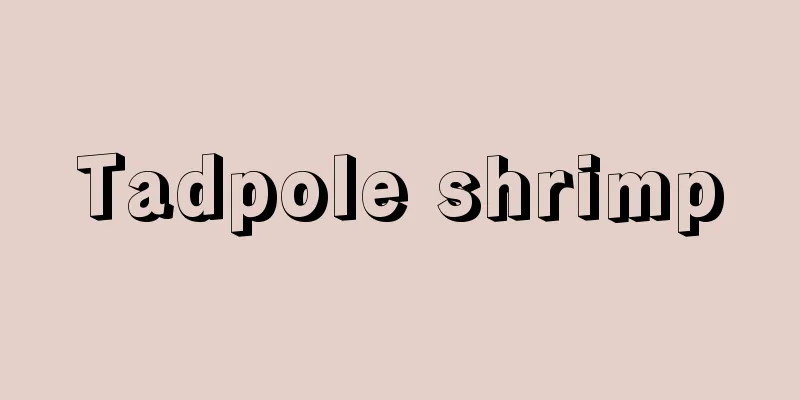Tadpole shrimp

|
A general term for aquatic animals of the family Triopsidae, order Dorsocampus, class Crustacea, phylum Arthropoda. Four species are known worldwide, three of which live in Japan. The Asian horseshoe shrimp Triops granarius and the American horseshoe shrimp T. longicaudatus are found from the Kanto region southwards, and the European horseshoe shrimp T. cancriformis is found in Yamagata Prefecture. The remaining species is the Australian horseshoe shrimp T. australiensis , found in Australia. They are freshwater creatures that appear in rice paddies and puddles, and all look very similar. The front half of their body is covered with an oval-shaped carapace about 2 cm long, and the abdominal segment has more than 40 pairs of legs, with a pair of tail whips about 2 cm long at the end. Their body color is dirty greenish brown to dark green, and the tail whips are brownish. They walk or swim quickly on the mud, laying durable eggs that are resistant to dryness and low temperatures, and then die about a month later. Depending on their habitat, there are populations that reproduce sexually and populations that reproduce parthenogenetically. They are omnivorous, eating microscopic organisms along with mud, and also the roots of weeds, so they are also known as "weed-eating bugs," and there have been attempts to use them as biological pesticides. [Masamichi Takeda] It is a freshwater fish that appears in rice paddies and puddles. Produced in Ueda City, Nagano Prefecture © Underwater Fort Enterprises Isamu Soyama "> Asian horseshoe crab (ecology) Source: Shogakukan Encyclopedia Nipponica About Encyclopedia Nipponica Information | Legend |
|
節足動物門甲殻綱背甲目カブトエビ科Triopsidaeの水生動物の総称。全世界で4種が知られ、そのうち日本には3種が生息している。アジアカブトエビTriops granariusとアメリカカブトエビT. longicaudatusが関東地方から南に、ヨーロッパカブトエビT. cancriformisが山形県に分布する。あとの種は、オーストラリアに分布するオーストラリアカブトエビT. australiensisである。 淡水産で、水田や水たまりに出現し、いずれもよく似ている。体の前半部は長さ2センチメートルほどの楕円(だえん)形の背甲で覆われ、腹節には40対以上の脚(あし)をもち、末端には約2センチメートルの1対の尾鞭(びべん)がある。体色は汚緑褐色ないし暗緑色で、尾鞭は褐色を帯びる。泥土上をすばやく歩いたり泳いだりし、乾燥や低温に強い耐久卵を産んだあと1か月ぐらいで死ぬ。産地によって、有性生殖をする個体群と単為生殖をする個体群がある。雑食性で、泥とともに微小生物を食べ、また雑草の根も食べるので「草取り虫」の名もあり、生物農薬として利用する試みもある。 [武田正倫] 淡水産で、水田や水たまりに出現する。長野県上田市産©水中フォート・エンタープライズ 楚山いさむ"> アジアカブトエビ(生態) 出典 小学館 日本大百科全書(ニッポニカ)日本大百科全書(ニッポニカ)について 情報 | 凡例 |
<<: Horseshoe crab (Japanese name: Kabutogani)
Recommend
Scarites aterrimus (English spelling) Scaritesaterrimus
…A general term for insects in the family Scarite...
Home - katei (English spelling)
The living space and atmosphere of individuals ce...
Colla
…Kala means "black" and Buran means &qu...
境 - iki (English spelling) threshold, limen (English), seuil (French), Schwelle (German)
A threshold or threshold value refers to the minim...
Hermann von Karinthia
...In Toledo and Sicily in Spain, as well as in c...
Basho (English spelling) Musa basjoo
A perennial plant of the Musaceae family. Native t...
Tsukioka [Hot Spring] - Tsukioka
This hot spring is located in Toyoura Town, Kitaka...
Basal metabolic rate
The minimum amount of energy metabolism required t...
Marek, KW (English spelling) MarekKW
…German journalist and author. His real name was ...
Hammerhead
A bird of the Hamerhead family of the Ciconiiform...
Tadamasa Taira
Year of death: July 28, 1156 (August 15, 1156) Yea...
Balkan Wars
Two wars were fought in the Balkans between 1912 ...
《Omochizuki》
...There are two pieces based on Nagauta. The com...
Ouchi dolls
...Also, when imperial envoys went to Edo, their ...
FDM hierarchy - FDM hierarchy
In frequency division multiplexing (FDM), group mo...









